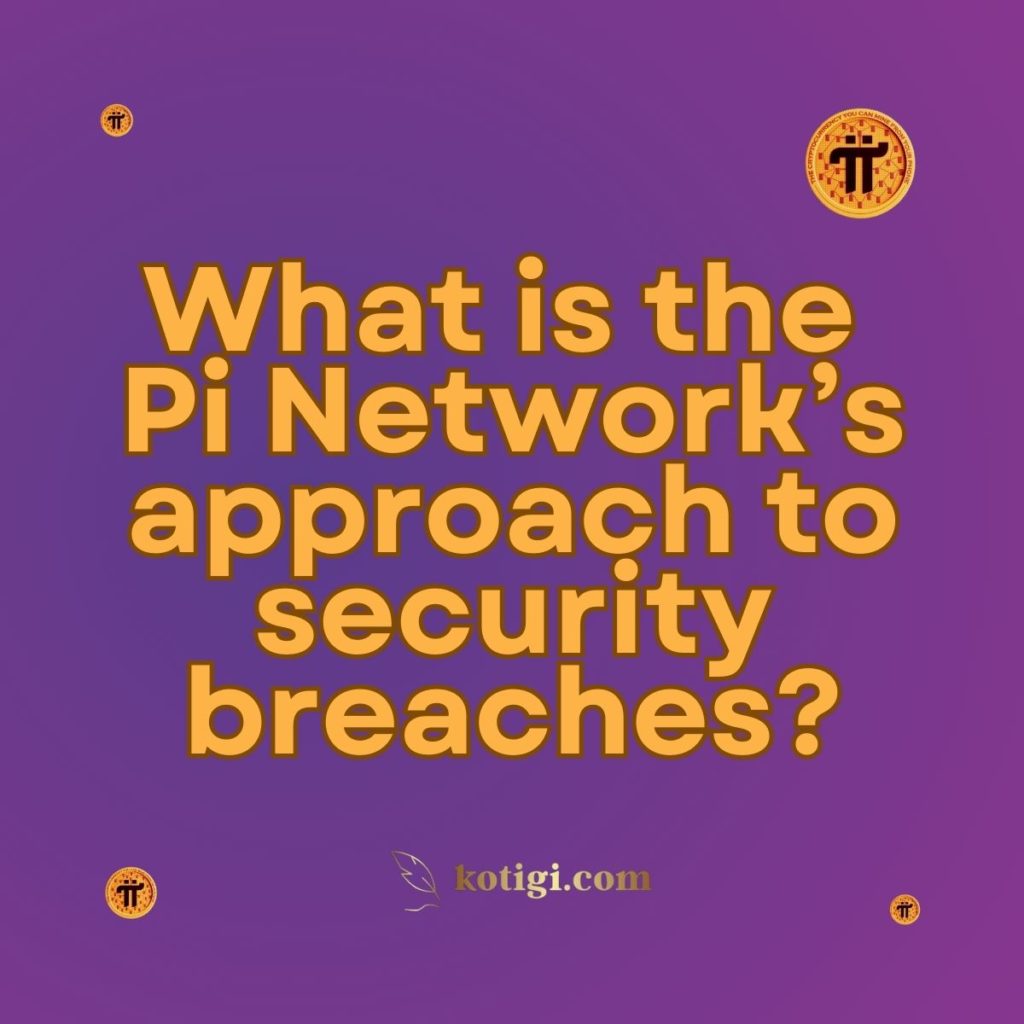
What is the Pi Network’s approach to security breaches?
Pi Network’s approach to security breaches centers on proactive measures, decentralized security, and user participation. By leveraging security circles, trusted nodes, and encryption, Pi Network minimizes vulnerabilities in its decentralized blockchain. The platform prioritizes transparency, regularly audits its security infrastructure, and encourages users to report any suspicious activity. In case of a security breach, Pi Network has protocols in place to identify, contain, and resolve issues swiftly to protect its users and the integrity of the network.
Introduction
As cryptocurrencies and blockchain technology continue to gain traction, security becomes a critical concern. Pi Network, a decentralized, mobile-first cryptocurrency platform, recognizes the importance of maintaining robust security to protect its millions of users. With an increasing number of participants mining Pi and engaging in transactions, ensuring the network’s safety against breaches, hacks, and fraud is paramount.
Pi Network employs a multi-layered approach to security, leveraging decentralized verification, user-led security circles, encryption, and regular audits. This article examines Pi Network’s approach to security breaches, outlining its preventative strategies, response plans, and the steps it takes to safeguard the network.
Decentralized Security Framework
Security Circles and Trust Networks
One of the core components of Pi Network’s security is its use of security circles. These are small groups of trusted individuals that each user selects. By relying on a web of interconnected trust relationships, Pi Network creates a decentralized layer of security that reduces the risk of breaches. Each user’s security circle plays a role in verifying transactions, which minimizes the possibility of fraudulent activity within the network.
Security circles contribute to the prevention of breaches by creating a community of trusted users who help secure the network. This trust-based model reduces reliance on centralized authorities, making it more difficult for malicious actors to compromise the system.
Node Validation and Network Security
Pi Network uses a decentralized model for validating transactions, with nodes spread across the globe to ensure that no single point of failure exists. Nodes act as validators in Pi’s consensus algorithm, verifying and securing transactions in real time. This decentralized structure makes the network resilient to attacks, as compromising one node would not affect the entire system.
Validator nodes are selected based on their trustworthiness and participation within the network, further enhancing security. By decentralizing transaction validation, Pi Network mitigates the risk of widespread security breaches.
Proactive Measures Against Breaches
Encryption and Data Protection
Pi Network employs strong encryption protocols to secure user data and communications. All transactions and user data are encrypted, ensuring that even if a breach were to occur, sensitive information would remain protected. This encryption applies to both the mobile app and the blockchain itself, safeguarding the privacy and integrity of user information.
Data protection is a top priority for Pi Network, and the platform continually updates its encryption methods to stay ahead of potential threats. By securing user data through encryption, Pi minimizes the risk of data breaches and unauthorized access.
Regular Security Audits
To maintain a secure environment, Pi Network regularly conducts security audits of its system. These audits help identify potential vulnerabilities, allowing the team to address any weaknesses before they can be exploited. Audits are performed both internally and by third-party cybersecurity firms to ensure objectivity and thoroughness.
By conducting frequent audits, Pi Network remains vigilant in its efforts to prevent breaches. This proactive approach is key to ensuring the long-term security of the platform.
Monitoring and Intrusion Detection
Pi Network employs advanced monitoring systems to detect unusual activity or potential security threats in real time. Intrusion detection systems (IDS) are used to monitor the network for any signs of malicious activity, such as unauthorized access attempts or abnormal transaction patterns. These systems enable the team to respond quickly to any potential breaches, minimizing their impact.
Real-time monitoring ensures that potential threats are identified and addressed swiftly. This reduces the risk of a security breach escalating and affecting the broader network.
User Participation in Security
Reporting Suspicious Activity
Pi Network encourages its users to report any suspicious activity they encounter. Whether it’s unusual behavior within the app, phishing attempts, or potential scams, users can flag these issues for review by the Pi Network team. This user-driven reporting system adds an extra layer of vigilance to the platform’s security efforts.
By involving the community in security efforts, Pi Network ensures that potential threats are identified quickly. Users act as the first line of defense against breaches, helping the platform maintain its integrity.
Educating Users on Security Best Practices
Pi Network places a strong emphasis on educating its users about security best practices. The platform regularly provides guidance on how to spot phishing attempts, avoid scams, and secure their accounts. By promoting awareness and knowledge, Pi empowers its users to take an active role in their own security.
User education is key to preventing breaches, as informed users are less likely to fall victim to social engineering attacks or other forms of exploitation. Pi Network’s efforts to educate its community play a vital role in minimizing security risks.
Incident Response to Security Breaches
Identifying and Containing Breaches
In the event of a security breach, Pi Network has a detailed response plan in place. The first step is to identify the breach and assess its scope. This involves determining the affected areas of the network and isolating any compromised systems to prevent further damage.
Pi’s decentralized structure aids in containing breaches quickly, as the impact of any single breach is limited to the affected nodes or security circles. By isolating compromised nodes or transactions, Pi Network can contain the breach and protect the rest of the network.
Communication and Transparency
Transparency is a key component of Pi Network’s approach to handling security breaches. If a breach occurs, Pi Network will promptly inform its users and provide clear communication about the nature of the breach, the steps being taken to address it, and how users can protect their accounts. This openness helps build trust within the community and ensures that users are aware of the platform’s response efforts.
Clear and honest communication is essential during a security breach. Pi Network’s commitment to transparency ensures that users remain informed and can take necessary precautions to protect their accounts and personal information.
Restoring Network Integrity
After containing a breach, Pi Network focuses on restoring the integrity of the affected systems. This includes repairing any vulnerabilities that may have been exploited and conducting a thorough audit to ensure that no additional breaches occurred. Pi Network’s technical team works diligently to restore the platform to full functionality while reinforcing its defenses to prevent future incidents.
The process of restoring network integrity may involve patching software vulnerabilities, updating security protocols, and improving monitoring systems to ensure that similar breaches do not occur in the future.
Long-Term Security Enhancements
Continuous Improvement of Security Protocols
Pi Network is committed to continuously improving its security infrastructure. The platform regularly updates its security protocols to address emerging threats and to stay ahead of potential vulnerabilities. By staying proactive and responsive to the evolving cybersecurity landscape, Pi Network ensures that its users remain protected.
- Advanced Encryption: Pi Network continuously upgrades its encryption protocols to stay ahead of cybercriminals.
- Security Partnerships: Pi collaborates with leading cybersecurity firms to implement the latest security technologies.
Ongoing User Education
Pi Network’s long-term approach to security includes ongoing user education. The platform provides regular updates on the latest security threats and offers tips on how users can protect themselves. This commitment to education ensures that the Pi community remains vigilant and informed, reducing the likelihood of successful security breaches.
Conclusion
Pi Network takes a comprehensive approach to preventing and responding to security breaches. By leveraging decentralized security circles, validator nodes, encryption, and regular audits, the platform minimizes its vulnerability to breaches. In the event of a breach, Pi Network acts swiftly to contain and resolve the issue, while maintaining transparency with its users. As Pi Network continues to grow, its proactive measures and commitment to security will ensure that users can participate in the ecosystem with confidence.
Key Takeaways
- Security Circles: Pi Network uses security circles of trusted users to decentralize security and prevent breaches.
- Encryption: All transactions and data are encrypted, protecting user information in case of a breach.
- User Reporting: Users play an active role in security by reporting suspicious activity and following best practices.
- Incident Response: Pi Network has protocols to quickly identify, contain, and resolve security breaches.
- Continuous Improvement: The platform regularly updates its security infrastructure to stay ahead of emerging threats.





